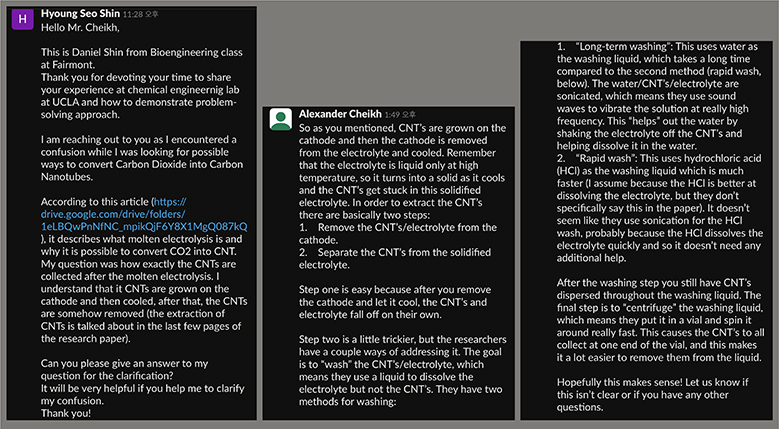“Is renewable energy the only solution to resolve CO2 emission from the coal industry?” This question arose during my Bioengineering class as we began learning how to approach problem-solving. Through the application of any biology and chemistry concepts, each student was encouraged to come up with the possible solution, either theoretical or improvements based on the current status.
While CO2 emission comes from many different industries, it is undeniable that the coal power plant industry is not only the major contributor to CO2 emission but also supplies almost 38% of energy needs in the world, and of 20% in the United States. Due to its contribution to CO2 emission, there has been a push to replace coal power plant industries with renewables such as solar, wind, or water-power generation industries. In addition, a lot of developed nations have established policies regarding coal industries to regulate the amount of CO2 emission. For example, in the US, Biden’s admission plans to shut down coal power facilities if they keep emitting a tremendous amount of CO2 from smokestacks.

There has been a push to replace coal power plants nationwide. However, several difficulties and concerns followed. Although alternative energy resources and renewable energy production are rapidly growing, it is not enough to completely replace the coal power industry. Even with the development of renewable energy resources, they cannot fulfill the entire energy demand of our society. Additionally, many employees and workers will lose their job when the coal industry shuts down, resulting in an unemployment crisis.
In the meantime, I found that the Carbon Capture and Sequestration (CCS) process will significantly lower the emission of CO2 from coal power plants. This process involves capturing CO2 from the flue of gas emitted from an industrial process and transports it through pipelines to be stored underground for the long term. It can be applied to coal power plant facilities, as well as to the entire smokestack industries to reduce CO2 emissions. The market of CCS is expected to increase up to $14.2 billion by 2025 globally, as demands for carbon capture are increasing due to government CO2 regulation policies.
On the other hand, there are also several flaws regarding CCS. First of all, it has not considered about storage cost of capture CO2. People have to store the captured CO2 deep underground forever and secure stored them to not be released into the atmosphere. Also, existing CCS facilities are often criticized for overestimating viability while underestimating costs, meaning coal power plant facilities need to pay the high cost just to lower CO2 emission and meet the government regulation.
Considering all aspects of CCS, it is undeniable that CCS needs improvements to transform coal power plants carbon-free efficiently. With that being said, my classmates and I discussed and investigated an efficient method to reduce CO2 emissions.
We finally agreed that utilizing captured CO2 by converting it into carbon nanotubes will be an efficient option throughout researches and discussions. Since captured CO2 is completely transformed into Carbon Nanotubes, companies or facilities no longer need to store and secure them and sell carbon nanotubes to earn additional profit. A carbon nanotube is ideal for applications that require high durability, conductivity, or strength, including aerospace engineering to simple applications such as golf clubs. Additionally, the carbon nanotube costs $100-200 in general for the cheapest products and up to $100,000 for expensive ones, due to the high demands and growth of the market. These advantages of Carbon nanotubes show that coal power plant facilities can benefit by selling converted carbon nanotubes to the market. Even though converting CO2 into carbon nanotube may be expensive, it would be an ideal solution that would benefit both coal power plants and the environment.
For further clarification, I have interviewed Alexander Cheikh, a graduate researcher at UCLA Nanotechnology laboratory. He spoke as a guest speaker to our class before, to learn possible ways to collect carbon nanotubes from captured CO2. “It is possible that carbon nanotubes can be collected after molten electrolysis. Electrolysis occurs at low electrical energy and high coulombic efficiency with a high yield of nanotubes”, he says. After all, Alex added that Carbon nanotubes would be removed from the cathode and later separated from solidified electrolyte through washing with liquid or hydrochloric acid. “Even with this complex theoretical procedure, it will still be an efficient and future-oriented method to utilize captured carbon dioxide,” he added.

Since climate change is becoming a serious environmental issue, we are responsible for resolving and making the Earth “greener.” While a lot of CO2 is emitted from coal industries, the current state of the art is not enough to eliminate CO2 that is release nor completely replace the industry. Therefore, converting CO2 into valuable materials such as carbon nanotubes can be a potential solution to be discovered. It also reveals that investigation on utilizing capture CO2 will be necessary and considered an assignment for our future generation.

Hyoung Seo Shin
10th grade
Fairmont Preparatory Academy

